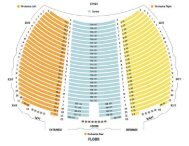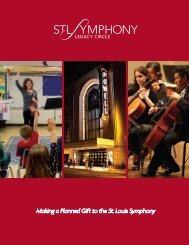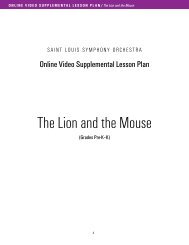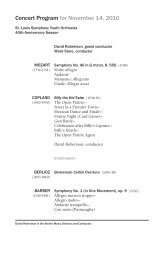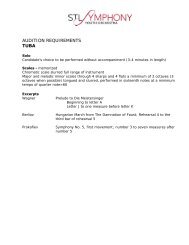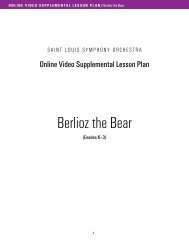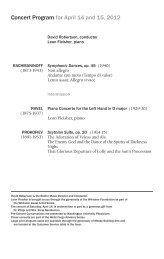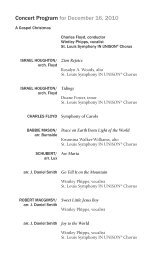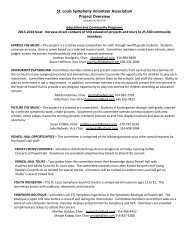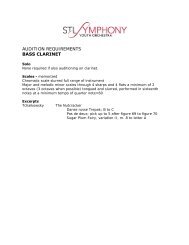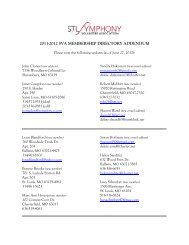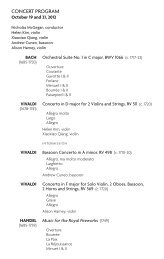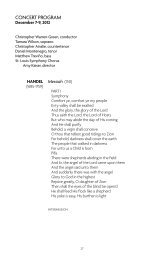Program NotesPDF (file size) - St. Louis Symphony
Program NotesPDF (file size) - St. Louis Symphony
Program NotesPDF (file size) - St. Louis Symphony
Create successful ePaper yourself
Turn your PDF publications into a flip-book with our unique Google optimized e-Paper software.
CONCERT PROGRAM<br />
May 9-12, 2013<br />
David Robertson, conductor<br />
Susanna Phillips, soprano<br />
Kelley O’Connor, mezzo-soprano<br />
Joseph Kaiser, tenor<br />
Corey McKern, baritone<br />
<strong>St</strong>. <strong>Louis</strong> <strong>Symphony</strong> Chorus<br />
Amy Kaiser, director<br />
BRUCKNER Motet: “Christus factus est”— (1884)<br />
(1824-1896)<br />
<strong>St</strong>. <strong>Louis</strong> <strong>Symphony</strong> Chorus<br />
Amy Kaiser, director<br />
Performed without pause<br />
BERG Act III from Wozzeck, op. 7 (1917-22)<br />
(1885-1935)<br />
Scene 1: Marie’s room—<br />
Scene 2: Forest path by a pool—<br />
Scene 3: A low tavern—<br />
Scene 4: Forest path by a pool—<br />
Scene 5: <strong>St</strong>reet before Marie’s door<br />
Corey McKern, baritone (Wozzeck)<br />
Susanna Phillips, soprano (Marie)<br />
Kelley O’Connor, mezzo-soprano (Margret)<br />
Keith Boyer, tenor (Hauptmann)<br />
Mark Freiman, bass (Doktor)<br />
<strong>St</strong>. <strong>Louis</strong> <strong>Symphony</strong> Chorus<br />
Amy Kaiser, director<br />
INTERMISSION<br />
BEETHOVEN <strong>Symphony</strong> No. 9 in D minor, op. 125 (1822-24)<br />
(1770-1827)<br />
Allegro ma non troppo, un poco maestoso<br />
Molto vivace<br />
Adagio molto e cantabile<br />
Presto; Allegro assai<br />
Susanna Phillips, soprano<br />
Kelley O’Connor, mezzo-soprano<br />
Joseph Kaiser, tenor<br />
Corey McKern, baritone<br />
<strong>St</strong>. <strong>Louis</strong> <strong>Symphony</strong> Chorus<br />
Amy Kaiser, director<br />
23
ACKNOWLEDGMENTS<br />
David Robertson is the Beofor Music Director and Conductor.<br />
Amy Kaiser is the AT&T Foundation Chair.<br />
The concert of Thursday, May 9, is underwritten in part by a generous gift from<br />
Mr. and Mrs. Walter L. Hawkins, Jr.<br />
The concert of Friday, May 10, is made possible with support from Merrill Lynch.<br />
The concert of Friday, May 10, is underwritten in part by a generous gift from<br />
Karen and Bert Condie III.<br />
The concert of Saturday, May 11, is underwritten in part by a generous gift from<br />
Mr. and Mrs. <strong>St</strong>uart A. Keck.<br />
The concert of Sunday, May 12, is underwritten in part by a generous gift from<br />
Mr. Richard G. Engelsmann.<br />
Pre-Concert Conversations are presented by Washington University Physicians.<br />
These concerts are presented by the Thomas A. Kooyumjian Family Foundation.<br />
These concerts are part of the Wells Fargo Advisors Series.<br />
Large print program notes are available through the generosity of Mosby<br />
Building Arts and are located at the Customer Service table in the foyer.<br />
24
VIENNA IN TWO CENTURIES<br />
BY PAUL SCHIAVO<br />
TIMELINKS<br />
1822-24<br />
BEETHOVEN<br />
<strong>Symphony</strong> No. 9 in<br />
D minor, op. 125<br />
Romantic English poet<br />
Percy Shelley drowns in<br />
Italy<br />
1884<br />
BRUCKNER<br />
Motet: “Christus<br />
factus est”<br />
Edgar Degas begins series<br />
of paintings of dancers<br />
1917-22<br />
BERG<br />
Act III from<br />
Wozzeck, op. 7<br />
Germany suffers defeat<br />
in World War I<br />
Vienna, whose musical legacy to the world is<br />
the focus of nine programs performed by the <strong>St</strong>.<br />
<strong>Louis</strong> <strong>Symphony</strong> this season, was home to some<br />
of the world’s great composers for more than<br />
150 years. At no time during this period was the<br />
Austrian capital musically still. However, it was<br />
particularly important at three times. The first<br />
came during the decades around 1800, when<br />
Haydn, Mozart, Beethoven, and Schubert were<br />
active there. Toward the end of the 19th century,<br />
the presence of Brahms and Bruckner revived<br />
Vienna’s standing as a center of compositional<br />
creativity. Finally, the early decades of the 20th<br />
century saw the emergence of what became<br />
known as “the Second Viennese School,” whose<br />
notable members included Alban Berg.<br />
Our program includes work from each of<br />
these periods of Viennese musical efflorescence.<br />
Anton Bruckner’s motet “Christus factus est” is<br />
an intimate piece by a composer best known for<br />
his mighty symphonies. Alban Berg used the<br />
radically new harmonic language of the Second<br />
Viennese School to compose searing operas.<br />
His masterpiece is Wozzeck, and its third act<br />
marries a haunting scenario to ingenious<br />
musical invention.<br />
In contrast to both the orthodox piety of<br />
“Christus factus est” and the tragedy of Wozzeck,<br />
Beethoven’s <strong>Symphony</strong> No. 9 is a magnificent<br />
expression of humanist hope and aspiration.<br />
Beginning with intimations of struggle, the work<br />
moves inexorably toward its jubilant conclusion,<br />
where instruments alone no longer suffice to<br />
express Beethoven’s sense of joy.<br />
25
ANTON BRUCKNER<br />
Motet: “Christus factus est”<br />
Born<br />
September 4, 1824,<br />
Ansfelden, near Linz, Austria<br />
Died<br />
October 11, 1896, Vienna<br />
First Performance<br />
November 9, 1884, in Vienna<br />
STL <strong>Symphony</strong> Premiere<br />
This week<br />
Scoring<br />
Unaccompanied chorus<br />
Performance Time<br />
approximately 5 minutes<br />
Born<br />
February 9, 1885, Vienna<br />
Died<br />
December 24, 1935, Vienna<br />
OLD AND NEW Scored for unaccompanied<br />
chorus, this piece is remarkable for its fusion<br />
of old and new. On one hand, the melodic lines<br />
generally are redolent of ancient ecclesiastical<br />
chant, and the contrapuntal echoes between<br />
different voices are a venerable feature of church<br />
music. As a result, this work seems to belong not<br />
so much to the 19th century, with its Romantic<br />
currents, as to a timeless tradition of church<br />
composition. At the same time, some of Bruckner’s<br />
harmonic shifts, as well as the piercing climax to<br />
which the music briefly rises, sound surprisingly<br />
modern, a harbinger of the innovations of Berg<br />
and other 20th-century composers.<br />
ALBAN BERG<br />
Act III from Wozzeck, op. 7<br />
A SOLDIER’S TALE Woyzeck, the fragmentary<br />
drama by Georg Büchner (1813-1837), was<br />
produced in Vienna for the first time in May<br />
1914. Among those who saw the play at this time<br />
was Alban Berg, who found himself transfixed by<br />
the tale of a hapless soldier in a heartless world.<br />
Almost at once he began forming ideas for an opera<br />
based on the play. Using the same early edition<br />
of Büchner’s work that had been performed in<br />
Vienna (and preserving its misspelling of the title<br />
and title character), Berg adapted his own libretto<br />
for the opera. Service in the Austrian army during<br />
World War I delayed the project, and Wozzeck did<br />
not reach completion until 1922.<br />
The opera’s title character is a downtrodden<br />
Everyman. Poor and unsophisticated, Wozzeck<br />
is preyed upon by his regimental captain and<br />
doctor and betrayed by Marie, the unwed mother<br />
of his young child. He reacts to browbeating from<br />
his officer and physician with stoic passivity, but<br />
Marie’s flagrant dalliance with a handsome drum<br />
major pushes him to despair and smoldering rage.<br />
TRAGIC CONCLUSION As Act III opens, Marie is<br />
in her room, reading the biblical story of Mary<br />
Magdalene, whose position as a “fallen woman”<br />
26
parallels her own. The scene shifts to a path near<br />
a pond, where Marie and Wozzeck walk together.<br />
As Wozzeck recalls their past together, Marie<br />
grows increasingly uneasy. She tries to flee, but<br />
Wozzeck draws a knife and kills her.<br />
In a tavern, Wozzeck tries to drown his guilt<br />
in drink. A folk song he sings only reminds him<br />
of Marie, as does a song by Margret, Marie’s<br />
neighbor. Margret notices blood on Wozzeck’s<br />
hand, impelling him to flee.<br />
Wozzeck returns to the pond, hoping to<br />
retrieve his knife. There he stumbles against<br />
Marie’s corpse. Imagining himself covered with<br />
blood, he wades into the pond and drowns. After<br />
the captain and doctor pass by, the scene returns<br />
to the quiet of nature. The opera concludes<br />
outside Marie’s house, where her son is playing.<br />
Another child brings news that his mother is<br />
dead. Uncomprehending, he continues playing a<br />
hopping game.<br />
MUSIC AND DRAMA By the time he composed<br />
Wozzeck, Berg had largely abandoned traditional<br />
harmony. The loss of that musical element<br />
compelled the composer to seek new ways of<br />
organizing his music, and in Wozzeck he did<br />
this with remarkable ingenuity. Each scene in<br />
the opera is based on some well-established<br />
compositional procedure: sonata, rondo, fugue,<br />
etc. In Act III, the scene in Marie’s room is<br />
musically constructed as a theme with variations.<br />
The scene of her death is built around a single<br />
pitch reiterated—by different instruments in the<br />
orchestra’s high, low, and middle registers—<br />
from start to finish. The scene of Wozzeck’s<br />
drowning unfolds through continual variation<br />
of a complex chord.<br />
Berg acknowledged these devices but<br />
downplayed their importance. The essential<br />
thing, he insisted, is the music’s role in bringing<br />
the drama to life. “From the moment the curtain<br />
rises until it falls for the last time,” Berg wrote,<br />
“there must be no one in the audience who<br />
notices all these diverse fugues and inventions,<br />
suites and sonatas, variations and passacaglias—<br />
no one who is aware of anything but this opera’s<br />
idea, which transcends the fate of Wozzeck.”<br />
First Performance<br />
December 14, 1925, in Berlin,<br />
Erich Kleiber conducted<br />
members of the Berlin<br />
<strong>St</strong>aatsoper<br />
STL <strong>Symphony</strong> Premiere<br />
January 7, 1949, Vladimir<br />
Golschmann conducted<br />
scenes from the opera, with<br />
soprano Judith Doniger<br />
Most Recent STL <strong>Symphony</strong><br />
Performance<br />
November 17, 1967, Eleazar<br />
De Carvalho conducted a<br />
concert version of the full<br />
opera, featuring soprano<br />
Evelyn Lear (Marie), mezzosoprano<br />
Natasha Kimmel<br />
(Margret), and baritone John<br />
Shirley-Quirk (Wozzeck)<br />
Scoring<br />
Wozzeck: baritone<br />
Marie: soprano<br />
Margret: mezzo-soprano<br />
Hauptmann: tenor<br />
Doktor: bass<br />
chorus<br />
4 flutes<br />
4 piccolos<br />
4 oboes<br />
English horn<br />
4 clarinets<br />
E-flat clarinet<br />
bass clarinet<br />
3 bassoons<br />
contrabassoon<br />
4 horns<br />
4 trumpets<br />
4 trombones<br />
tuba<br />
timpani<br />
percussion<br />
harp<br />
upright piano<br />
celesta<br />
strings<br />
Performance Time<br />
approximately 25 minutes<br />
27
LUDWIG VAN BEETHOVEN<br />
<strong>Symphony</strong> No. 9 in D minor, op. 125<br />
Born<br />
December 16, 1770, Bonn<br />
Died<br />
March 26, 1827, Vienna<br />
First Performance<br />
May 7, 1824, in Vienna.<br />
Beethoven, who was by<br />
this time almost completely<br />
deaf, was nominally the<br />
conductor; the orchestra<br />
and chorus followed Michael<br />
Umlauf, music director of the<br />
Austrian imperial theater.<br />
STL <strong>Symphony</strong> Premiere<br />
December 21, 1928, with<br />
soprano Helen Traubel,<br />
contralto Viola Silva, tenor<br />
Laurance Wolfe, baritone<br />
Jerome Swinford, Apollo-<br />
Morning Choral Clubs, Emil<br />
Oberhoffer conducting<br />
Most Recent STL <strong>Symphony</strong><br />
Performance<br />
May 10, 2009, with soprano<br />
Heidi Grant Murphy, mezzosoprano<br />
Jennifer Dudley,<br />
tenor Brandon Jovanovich,<br />
bass-baritone Jonathan<br />
Lemalu, <strong>St</strong>. <strong>Louis</strong> <strong>Symphony</strong><br />
Chorus under the direction<br />
of Amy Kaiser, David<br />
Robertson conducting<br />
THE SYMPHONIST SILENT Between 1800 and<br />
1812, Beethoven transformed the symphony as<br />
no other composer had or has done. His first two<br />
works of this kind, written in 1800 and 1802,<br />
summarized the Classical-period symphony,<br />
which had been his inheritance from Mozart and<br />
Haydn, the great symphonists of the late 18th<br />
century. With his <strong>Symphony</strong> No. 3, the epochal<br />
Sinfonia eroica of 1804, Beethoven expanded<br />
both the musical and emotional scope of the<br />
genre, imparting to it the heroic spirit that would<br />
become a hallmark of 19th-century Romanticism.<br />
The works that followed proved Beethoven’s<br />
symphonic style capable of expressing all that he<br />
found in nature, both the nature of the Vienna<br />
woods and human nature, in others and in his<br />
tempestuous self.<br />
Then, beginning in 1813, no symphony<br />
came from Beethoven’s pen for more than a<br />
decade. Much of this period saw a marked<br />
decrease in the composer’s output and his<br />
progressive withdrawal from most social<br />
contact. He was, during this time, embroiled in<br />
emotional and legal turmoil engendered by the<br />
custody of his troubled nephew. Moreover, he<br />
was now almost completely deaf and bereft of<br />
intimate companionship.<br />
These difficult personal circumstances<br />
might alone have explained the relative silence of<br />
the recently so prolific composer. But the work<br />
of Beethoven’s final years suggests that he was<br />
passing through a creative crisis as well, for when<br />
the flow of compositions at last resumed, the<br />
music was distinct from anything their author<br />
had done before.<br />
INNOVATION AND CONTINUITY In his late<br />
compositions, Beethoven seems to be reaching<br />
in opposite directions at once. His tone is more<br />
intimate, more personal, yet the scale on which<br />
his ideas take form has once again expanded.<br />
There is a greater feeling of maturity in his<br />
musical utterances, but his melodies often have<br />
the simplicity of folk tunes. And although he<br />
clearly is formulating new concepts of musical<br />
28
design and harmonic syntax, he takes pains to<br />
incorporate such anachronisms as fugal textures<br />
in his compositions.<br />
Nowhere are the contradictions that<br />
informed Beethoven’s late music more evident<br />
than in his <strong>Symphony</strong> No. 9, completed in<br />
1824. And nowhere, in either his own earlier<br />
symphonies or those of other composers, are<br />
there precedents for the grandeur and fervor of<br />
this work, or for the extraordinary conception of<br />
the symphony’s choral finale.<br />
But while the <strong>Symphony</strong> No. 9 seems in<br />
many ways sui generis, it also represents an<br />
extension and culmination of various artistic<br />
concerns that had preoccupied Beethoven<br />
throughout his career. The triumph of the spirit,<br />
the psychological progression from pathos to<br />
joy that had been the theme of the Third and<br />
Fifth Symphonies, the opera Fidelio and the<br />
Egmont Overture, found its greatest expression in<br />
Beethoven’s final symphonic essay.<br />
Even the use of Friedrich Schiller’s ode An<br />
die Freude, the “Ode to Joy,” as the basis of the<br />
finale stems from Beethoven’s youth. As a young<br />
man he had sketched a setting of these verses,<br />
and the idea of completing it never left him. Thus,<br />
the Ninth <strong>Symphony</strong> was as much fulfillment as<br />
breakthrough, a work that crowned Beethoven’s<br />
efforts to articulate in music the 19th century’s<br />
great humanist vision, even while it opened new<br />
vistas in the field of symphonic composition.<br />
Scoring<br />
2 flutes<br />
piccolo<br />
2 oboes<br />
2 clarinets<br />
2 bassoons<br />
contrabassoon<br />
4 horns<br />
2 trumpets<br />
3 trombones<br />
timpani<br />
percussion<br />
strings<br />
solo soprano, alto, tenor and<br />
bass voices<br />
chorus<br />
Performance Time<br />
approximately 65 minutes<br />
<strong>Program</strong> notes © 2013 by Paul Schiavo<br />
29
DAVID ROBERTSON<br />
BEOFOR MUSIC DIRECTOR AND CONDUCTOR<br />
David Robertson and the<br />
<strong>St</strong>. <strong>Louis</strong> <strong>Symphony</strong> return<br />
to Carnegie Hall with a<br />
concert performance of<br />
Britten’s Peter Grimes in<br />
November 2013.<br />
David Robertson has established himself as<br />
one of today’s most sought-after American<br />
conductors, and has forged close relationships<br />
with major orchestras around the world through<br />
his exhilarating music-making and stimulating<br />
ideas. In fall 2012, Robertson launched his<br />
eighth season as Music Director of the 133-yearold<br />
<strong>St</strong>. <strong>Louis</strong> <strong>Symphony</strong>. In January 2014, while<br />
continuing as <strong>St</strong>. <strong>Louis</strong> <strong>Symphony</strong> music director,<br />
Robertson also will assume the post of Chief<br />
Conductor and Artistic Director of the Sydney<br />
<strong>Symphony</strong> in Australia.<br />
In September 2012, the <strong>St</strong>. <strong>Louis</strong> <strong>Symphony</strong><br />
and Robertson embarked on a European tour,<br />
which included appearances at London’s BBC<br />
Proms, at the Berlin and Lucerne festivals, and<br />
culminated at Paris’s Salle Pleyel. In March<br />
2013 Robertson and his orchestra returned<br />
to California for their second tour of the<br />
season, which included an intensive three-day<br />
residency at the University of California-Davis<br />
and performance at the Mondavi Center for the<br />
Performing Arts, with violinist James Ehnes as<br />
soloist. The orchestra also performed at venues<br />
in Costa Mesa, Palm Desert, and Santa Barbara,<br />
with <strong>St</strong>. <strong>Louis</strong> <strong>Symphony</strong> Principal Flute, Mark<br />
Sparks, as soloist.<br />
In addition to his current position with the<br />
<strong>St</strong>. <strong>Louis</strong> <strong>Symphony</strong>, Robertson is a frequent<br />
guest conductor with major orchestras and<br />
opera houses around the world. During the<br />
2012-13 season he appears with prestigious U.S.<br />
orchestras such as the New York Philharmonic,<br />
Los Angeles Philharmonic, and San Francisco<br />
<strong>Symphony</strong>, as well as internationally with the<br />
Royal Concertgebouw Orchestra, Vienna Radio<br />
<strong>Symphony</strong> Orchestra, Israel Philharmonic, and<br />
Ensemble Intercontemporain.<br />
Born in Santa Monica, California, David<br />
Robertson was educated at London’s Royal<br />
Academy of Music, where he studied horn<br />
and composition before turning to orchestral<br />
conducting.<br />
30
SUSANNA PHILLIPS<br />
Alabama-born soprano Susanna Phillips,<br />
recipient of the Metropolitan Opera’s 2010<br />
Beverly Sills Artist Award, continues to establish<br />
herself as one of today’s most sought-after<br />
singing actors and recitalists. In the 2012-<br />
13 season Phillips took the stage of the Met<br />
for her fifth consecutive season, this time to<br />
perform Donna Anna in Mozart’s Don Giovanni,<br />
conducted by Edward Gardner. Her opera season<br />
in New York City continued with her return to<br />
the Perlman stage at Carnegie Hall for a special<br />
concert performance, portraying <strong>St</strong>ella in André<br />
Previn’s A <strong>St</strong>reetcar Named Desire opposite Renée<br />
Fleming—a role which she will then perform at<br />
Lyric Opera of Chicago. Phillips also made her<br />
solo recital debut at Carnegie Hall this season,<br />
presenting a program with accompanist Myra<br />
Huang in Weill Recital Hall.<br />
Other 2012–13 operatic highlights include<br />
Phillips’s return to Santa Fe Opera as the<br />
Countess in The Marriage of Figaro, and a concert<br />
production of Idomeneo at the Ravinia Festival<br />
under the direction of James Conlon. Symphonic<br />
appearances include Mozart’s Requiem with<br />
the Baltimore <strong>Symphony</strong> Orchestra, the<br />
Lord Nelson Mass with Music of the Baroque<br />
in Chicago, Knoxville: Summer of 1915 with<br />
Alabama <strong>Symphony</strong>, performances with Musica<br />
Sacra led by Kent Tritle at Alice Tully Hall, and<br />
Paul Moravec’s Blizzard Voices with the Oratorio<br />
Society of New York at Carnegie Hall.<br />
Born in Birmingham, Alabama and raised<br />
in Huntsville, Susanna Phillips is grateful for the<br />
ongoing support of her community in her career.<br />
She sang <strong>St</strong>rauss’s Four Last Songs and gave her<br />
first concert performances in the title role of Lucia<br />
di Lammermoor with the Huntsville <strong>Symphony</strong>.<br />
Susanna Phillips most recently performed<br />
with the <strong>St</strong>. <strong>Louis</strong> <strong>Symphony</strong> in April 2012.<br />
Susanna Phillips sings<br />
the role of Ellen Orford<br />
in <strong>St</strong>. <strong>Louis</strong> <strong>Symphony</strong><br />
performances of Peter<br />
Grimes at Powell<br />
and Carnegie halls in<br />
November 2013.<br />
31
KELLEY O’CONNOR<br />
Zachary Maxwell <strong>St</strong>ertZ<br />
Kelley O’Connor opened<br />
the <strong>St</strong>. <strong>Louis</strong> <strong>Symphony</strong>’s<br />
2011-12 season performing<br />
<strong>St</strong>ravinsky’s Les Noces.<br />
Possessing a voice of uncommon allure, musical<br />
sophistication far beyond her years, and intuitive<br />
and innate dramatic artistry, the Grammy Awardwinning<br />
mezzo-soprano Kelley O’Connor has<br />
emerged as one of the most compelling performers<br />
of her generation. During the 2012-13 season, the<br />
California native’s impressive calendar included<br />
John Adams’s The Gospel According to the Other<br />
Mary in a world premiere staging by Peter Sellars<br />
performed in America and Europe with the Los<br />
Angeles Philharmonic under Gustavo Dudamel’s<br />
baton, and a role debut as Suzuki in Madama<br />
Butterfly in a new production by Lillian Groag at<br />
Boston Lyric Opera.<br />
Concert appearances of the season<br />
included Peter Lieberson’s Neruda Songs both<br />
with Christoph Eschenbach and the National<br />
<strong>Symphony</strong> Orchestra and with Robert Spano<br />
and the Toronto <strong>Symphony</strong> Orchestra, Debussy’s<br />
La Damoiselle élue and the Duruflé Requiem with<br />
Donald Runnicles and the Atlanta <strong>Symphony</strong><br />
Orchestra, Beethoven’s <strong>Symphony</strong> No. 9 with<br />
Manfred Honeck and the Pittsburgh <strong>Symphony</strong>,<br />
<strong>Louis</strong> Langrée and the Cincinnati <strong>Symphony</strong>, and<br />
with Leonard Slatkin and the Detroit <strong>Symphony</strong>,<br />
as well as Lieberson’s The World in Flower with<br />
Grant Gershon and the Los Angeles Master<br />
Chorale. The artist is pleased both to return to the<br />
City of Birmingham <strong>Symphony</strong> Orchestra with<br />
Edward Gardner conducting a program of Elgar’s<br />
Sea Pictures and Britten’s Spring <strong>Symphony</strong> and to<br />
debut with the Netherlands Radio Philharmonic<br />
Orchestra with Adams’s The Gospel According to<br />
the Other Mary led by Markus <strong>St</strong>enz.<br />
Last season, O’Connor brought “her smoky<br />
sound and riveting stage presence” (The New York<br />
Times) to performances as Ursule in Berlioz’s<br />
Béatrice et Bénédict with Opera Boston, and to her<br />
signature role as Federico García Lorca in a Peter<br />
Sellars staging of Golijov’s Ainadamar at Teatro<br />
Real in Madrid.<br />
Kelley O’Connor most recently performed<br />
with the <strong>St</strong>. <strong>Louis</strong> <strong>Symphony</strong> in September 2011.<br />
32
JOSEPH KAISER<br />
<strong>St</strong>arring as Tamino in the Kenneth Branagh<br />
film adaptation of The Magic Flute, conducted<br />
by James Conlon and released in 2007, Joseph<br />
Kaiser is recognized by audiences for his beauty<br />
of tone, intelligence of programming, and innate<br />
sense of style and elegance. He is internationally<br />
acclaimed as one of the most gifted artists of<br />
his generation and enjoys success in opera,<br />
oratorio, and concert throughout North<br />
America and Europe.<br />
Kaiser’s 2012-13 season began with<br />
performances as Flamand in <strong>St</strong>rauss’s Capriccio<br />
at the Opéra National de Paris in a production<br />
by Robert Carsen and conducted by Philippe<br />
Jordan. Operatic engagements also included<br />
Houston Grand Opera’s mounting of the<br />
Francesca Zambello production of Showboat as<br />
the leading man Gaylord Ravenal, Dominick<br />
Argento’s The Aspern Papers at the Dallas Opera,<br />
Tamino in Robert Carsen’s production of The<br />
Magic Flute with Sir Simon Rattle conducting the<br />
Berlin Philharmonic at Teatro Real in Madrid,<br />
semi-staged performances of Capriccio at the<br />
Royal Opera House, Covent Garden led by Sir<br />
Andrew Davis, and Christof Loy’s production of<br />
Gluck’s Alceste at the Vienna <strong>St</strong>ate Opera in the<br />
role of Admète. Concert engagements included<br />
Beethoven’s <strong>Symphony</strong> No. 9 with the Toronto<br />
<strong>Symphony</strong> conducted by Jiří Bělohlávek.<br />
His concert schedule has included<br />
performances of the Berlioz Requiem under<br />
Marek Janowski with the combined forces of the<br />
Tonhalle-Orchester Zürich and the Orchestre<br />
de la Suisse Romande as well as with Donald<br />
Runnicles, both with the Atlanta <strong>Symphony</strong><br />
Orchestra and the Berliner Philharmoniker;<br />
Beethoven’s <strong>Symphony</strong> No. 9 with Christoph von<br />
Dohnányi and the Boston <strong>Symphony</strong> Orchestra,<br />
with Ivor Bolton and the Wiener Symphoniker,<br />
and with Christoph Eschenbach and the Chicago<br />
<strong>Symphony</strong> Orchestra; <strong>St</strong>ravinsky’s Pulcinella<br />
with Roberto Abbado and the Saint Paul<br />
Chamber Orchestra; and Mendelssohn’s Elijah<br />
with Yannick Nézet-Séguin and the Orchestre<br />
Métropolitain du Grand Montréal.<br />
Dario aco<strong>St</strong>a<br />
Joseph Kaiser makes his <strong>St</strong>.<br />
<strong>Louis</strong> <strong>Symphony</strong> debut with<br />
these performances.<br />
33
COREY MCKERN<br />
Corey McKern makes his<br />
<strong>St</strong>. <strong>Louis</strong> <strong>Symphony</strong> debut<br />
this week.<br />
Award-winning baritone Corey McKern continuously<br />
earns critical acclaim and accolades in<br />
every appearance he makes. This season, engagements<br />
included his debut with Austin Lyric<br />
Opera as Silvio in I Pagliacci, his role debut as<br />
Dandini in La Cenerentola with Nashville Opera,<br />
the Count in The Marriage of Figaro with Syracuse<br />
Opera, Anthony in Sweeney Todd with Pensacola<br />
Opera, King Henry II in Becket with Long Island<br />
Masterworks, and Papageno in The Magic Flute<br />
with Opera Omaha and Opera Birmingham.<br />
With the Santa Fe Opera he has performed<br />
Marcello in La bohéme, Masetto in Don Giovanni,<br />
Pallante in Agrippina, The Shoes for the Santo Nino,<br />
and the First Shepherd in Daphne. As house<br />
favorite at Opera Birmingham he has performed<br />
as Enrico in Lucia di Lammermoor, Escamillo in<br />
Carmen, Ping in Turandot, Figaro in The Barber of<br />
Seville, and the Count in The Marriage of Figaro.<br />
An active concert performer, McKern made<br />
his Carnegie Hall debut in the Fauré Requiem,<br />
and recently returned to the prestigious concert<br />
hall for John Rutter’s Mass of the Children<br />
and Mozart’s Requiem. Other recent concert<br />
engagements include Mahler’s Rückert-Lieder<br />
with the Missoula <strong>Symphony</strong>, and performances<br />
with the New Choral Society in Handel’s Messiah,<br />
Brahms’s Ein deutsches Requiem, and Orff’s<br />
Carmina burana, which he also performed with<br />
the Yakima <strong>Symphony</strong> Orchestra and with the<br />
San Juan <strong>Symphony</strong> in Colorado. His oratorio<br />
credits include Vaughan Williams’s Dona Nobis<br />
Pacem and a concert of operetta highlights with<br />
the Indianapolis <strong>Symphony</strong>.<br />
McKern is a former grant recipient from the<br />
Sullivan Foundation, as well as the first place<br />
winner of Opera Birmingham, Shreveport Opera,<br />
and Mobile Opera competitions. He holds a<br />
Master of Music degree from Indiana University,<br />
and Bachelor of Music Education from<br />
Mississippi <strong>St</strong>ate University. He is also a graduate<br />
of the Seattle Opera Young Artist <strong>Program</strong>.<br />
34
AMY KAISER<br />
AT&T FOUNDATION CHAIR<br />
One of the country’s leading choral directors,<br />
Amy Kaiser has conducted the <strong>St</strong>. <strong>Louis</strong><br />
<strong>Symphony</strong> in Handel’s Messiah, Schubert’s Mass<br />
in E-flat, Vivaldi’s Gloria, and sacred works by<br />
Haydn and Mozart as well as Young People’s<br />
Concerts. She has made eight appearances as<br />
guest conductor for the Berkshire Choral Festival<br />
in Sheffield, Massachusetts, Santa Fe, and at<br />
Canterbury Cathedral. As Music Director of the<br />
Dessoff Choirs in New York for 12 seasons, she<br />
conducted many performances of major works at<br />
Lincoln Center. Other conducting engagements<br />
include concerts at Chicago’s Grant Park Music<br />
Festival and more than fifty performances with the<br />
Metropolitan Opera Guild. Principal Conductor<br />
of the New York Chamber <strong>Symphony</strong>’s School<br />
Concert Series for seven seasons, Kaiser also led<br />
many programs for the 92nd <strong>St</strong>reet Y’s acclaimed<br />
Schubertiade. She has conducted over twenty-five<br />
operas, including eight contemporary premieres.<br />
A frequent collaborator with Professor Peter<br />
Schickele on his annual PDQ Bach concerts<br />
at Carnegie Hall, Kaiser made her Carnegie<br />
Hall debut conducting PDQ’s Consort of Choral<br />
Christmas Carols. She also led the Professor in<br />
PDQ Bach’s Canine Cantata “Wachet Arf” with<br />
the New Jersey <strong>Symphony</strong>.<br />
Kaiser has led master classes in choral<br />
conducting at Indiana University Jacobs School<br />
of Music, served as faculty for a Chorus America<br />
conducting workshop, and as a panelist for the<br />
National Endowment for the Arts. An active<br />
guest speaker, Kaiser teaches monthly classes for<br />
adults in symphonic and operatic repertoire and<br />
presents “Illuminating Opera” for four weeks in<br />
April at Opera Theatre of <strong>St</strong>. <strong>Louis</strong>.<br />
Amy Kaiser has prepared choruses for the<br />
New York Philharmonic, Ravinia Festival, Mostly<br />
Mozart Festival, and Opera Orchestra of New<br />
York. She also served as faculty conductor and<br />
vocal coach at Manhattan School of Music and<br />
the Mannes College of Music. An alumna of Smith<br />
College, she was awarded the Smith College<br />
Medal for outstanding professional achievement.<br />
Amy Kaiser directs the<br />
<strong>St</strong>. <strong>Louis</strong> <strong>Symphony</strong> Chorus<br />
in Britten’s Peter Grimes,<br />
Bach’s Christmas Oratorio,<br />
Verdi’s Requiem, and Orff’s<br />
Carmina burana in the<br />
2013-14 season.<br />
35
ST. LOUIS SYMPHONY CHORUS 2012-2013<br />
Amy Kaiser<br />
Director<br />
Leon Burke, III<br />
Assistant Director<br />
Gail Hintz<br />
Accompanist<br />
Susan Patterson<br />
Manager<br />
Nancy Davenport Allison<br />
Rev. Fr. <strong>St</strong>ephan Baljian<br />
<strong>St</strong>ephanie A. Ball<br />
Nick Beary<br />
Rudi J. Bertrand<br />
Annemarie Bethel-Pelton<br />
Paula N. Bittle<br />
Jerry Bolain<br />
Michael Bouman<br />
Richard F. Boyd<br />
Keith Boyer<br />
Pamela A. Branson<br />
Bonnie Brayshaw<br />
Marella Briones<br />
Daniel P. Brodsky<br />
Buron F. Buffkin, Jr.<br />
Leon Burke, III<br />
Cherstin Byers<br />
Leslie Caplan<br />
Maureen A. Carlson<br />
Victoria Carmichael<br />
Mark P. Cereghino<br />
Jessica Klingler Cissell<br />
Rhonda Collins Coates<br />
Timothy A. Cole<br />
Derek Dahlke<br />
Laurel Ellison Dantas<br />
Deborah Dawson<br />
Zachary Devin<br />
Mary C. Donald<br />
<strong>St</strong>ephanie M. Engelmeyer<br />
Ladd Faszold<br />
Jasmine J. Fazzari<br />
Heather Fehl<br />
Robin D. Fish, Jr. Shelly Ragan Pickard<br />
Alan Freed<br />
Sarah Price<br />
Mark Freiman<br />
Valerie Reichert<br />
Amy Garcés<br />
Kate Reimann<br />
Amy Gatschenberger David Ressler<br />
Lara Gerassi<br />
Gregory J. Riddle<br />
Megan E. Glass<br />
Patti Ruff Riggle<br />
Susan Goris<br />
<strong>St</strong>ephanie Diane<br />
Karen S. Gottschalk Robertson<br />
Jacqueline Gross Terree Rowbottom<br />
Susan H. Hagen Paul N. Runnion<br />
Clifton D. Hardy Jennifer Ryrie<br />
Nancy J. Helmich Susan Sampson<br />
Ellen Henschen Patricia Scanlon<br />
Jeffrey E. Heyl<br />
Mark V. Scharff<br />
Lori Hoffman<br />
Samantha Nicole Schmid<br />
Matthew S. Holt Paula K. Schweitzer<br />
Allison Hoppe<br />
Lisa Sienkiewicz<br />
Heather Humphrey Janice Simmons-Johnson<br />
Kerry H. Jenkins John William Simon<br />
Madeline Kaufman Charles G. Smith<br />
Jennifer Klauder Shirley Bynum Smith<br />
Elena Korpalski Joshua <strong>St</strong>anton<br />
Paul V. Kunnath Adam <strong>St</strong>efo<br />
Kendra Lee<br />
David <strong>St</strong>ephens<br />
Debby Lennon<br />
Benna D. <strong>St</strong>okes<br />
Gregory C. Lundberg Greg <strong>St</strong>orkan<br />
Gina Malone<br />
Maureen Taylor<br />
Jamie Lynn Marble Michelle D. Taylor<br />
Jan Marra<br />
Justin Thomas<br />
Lee Martin<br />
Natanja Tomich<br />
Alicia Matkovich Pamela M. Triplett<br />
Daniel Mayo<br />
David R. Truman<br />
Rachael McCreery Greg Upchurch<br />
Elizabeth Casey McKinney Robert Valentine<br />
Scott Meidroth<br />
Kevin Vondrak<br />
Claire Minnis<br />
Samantha Wagner<br />
Brian Mulder<br />
Nancy Maxwell Walther<br />
Johanna Nordhorn Keith Wehmeier<br />
Duane L. Olson Nicole C. Weiss<br />
Nicole Orr<br />
Dennis Willhoit<br />
Heather McKenzie Paul A. Williams<br />
Patterson<br />
Mary Wissinger<br />
Susan Patterson Susan Donahue Yates<br />
Matt Pentecost<br />
Carl S. Zimmerman<br />
Brian Pezza<br />
36
AUDIENCE INFORMATION<br />
BOX OFFICE HOURS<br />
Monday-Saturday, 10am-6pm; Weekday<br />
and Saturday concert evenings through<br />
intermission; Sunday concert days<br />
12:30pm through intermission.<br />
TO PURCHASE TICKETS<br />
Box Office: 314-534-1700<br />
Toll Free: 1-800-232-1880<br />
Online: stlsymphony.org<br />
Fax: 314-286-4111<br />
A service charge is added to all<br />
telephone and online orders.<br />
SEASON TICKET EXCHANGE POLICIES<br />
If you can’t use your season tickets,<br />
simply exchange them for another<br />
Wells Fargo Advisors subscription<br />
concert up to one hour prior to your<br />
concert date. To exchange your tickets,<br />
please call the Box Office at 314-534-<br />
1700 and be sure to have your tickets<br />
with you when calling.<br />
GROUP AND DISCOUNT TICKETS<br />
314-286-4155 or 1-800-232-1880 Any<br />
group of 20 is eligible for a discount on<br />
tickets for select Orchestral, Holiday,<br />
or Live at Powell Hall concerts. Call<br />
for pricing.<br />
Special discount ticket programs are<br />
available for students, seniors, and<br />
police and public-safety employees.<br />
Visit stlsymphony.org for more<br />
information.<br />
37<br />
POLICIES<br />
You may store your personal<br />
belongings in lockers located on the<br />
Orchestra and Grand Tier Levels at a<br />
cost of 25 cents.<br />
Infrared listening headsets are available<br />
at Customer Service.<br />
Cameras and recording devices are<br />
distracting for the performers and<br />
audience members. Audio and video<br />
recording and photography are strictly<br />
prohibited during the concert. Patrons<br />
are welcome to take photos before the<br />
concert, during intermission, and after<br />
the concert.<br />
Please turn off all watch alarms, cell<br />
phones, pagers, and other electronic<br />
devices before the start of the concert.<br />
All those arriving after the start of the<br />
concert will be seated at the discretion<br />
of the House Manager.<br />
Age for admission to STL <strong>Symphony</strong><br />
and Live at Powell Hall concerts<br />
vary, however, for most events the<br />
recommended age is five or older. All<br />
patrons, regardless of age, must have<br />
their own tickets and be seated for all<br />
concerts. All children must be seated<br />
with an adult. Admission to concerts is<br />
at the discretion of the House Manager.<br />
Outside food and drink are not<br />
permitted in Powell Hall. No food or<br />
drink is allowed inside the auditorium,<br />
except for select concerts.<br />
Powell Hall is not responsible for<br />
the loss or theft of personal property.<br />
To inquire about lost items, call<br />
314-286-4166.<br />
POWELL HALL RENTALS<br />
Select elegant Powell Hall for your next<br />
special occasion.<br />
Visit stlsymphony.org/rentals<br />
for more information.
POWELL HALL<br />
BALCONY LEVEL<br />
(TERRACE CIRCLE, GRAND CIRCLE)<br />
WHEELCHAIR LIFT<br />
BALCONY LEVEL<br />
(TERRACE CIRCLE, GRAND CIRCLE)<br />
WHEELCHAIR LIFT<br />
GRAND TIER LEVEL<br />
(DRESS CIRCLE, DRESS CIRCLE BOXES,<br />
GRAND TIER BOXES & LOGE)<br />
GRAND TIER LEVEL<br />
(DRESS CIRCLE, DRESS CIRCLE BOXES,<br />
GRAND TIER BOXES & LOGE)<br />
MET BAR<br />
TAXI PICK UP<br />
DELMAR<br />
MET BAR<br />
TAXI PICK UP<br />
DELMAR<br />
ORCHESTRA LEVEL<br />
(PARQUET, ORCHESTRA RIGHT & LEFT)<br />
BOUTIQUE<br />
ORCHESTRA LEVEL<br />
(PARQUET, ORCHESTRA RIGHT & LEFT)<br />
BOUTIQUE<br />
KEY<br />
KEY<br />
LOCKERS<br />
LOCKERS<br />
WOMEN’S RESTROOM<br />
WOMEN’S RESTROOM<br />
MEN’S MEN’S RESTROOM RESTROOM<br />
ELEVATOR<br />
WIGHTMAN<br />
WIGHTMAN<br />
GRAND<br />
GRAND FOYER<br />
FOYER<br />
CUSTOMER<br />
SERVICE<br />
CUSTOMER<br />
SERVICE<br />
TICKET LOBBY<br />
TICKET LOBBY<br />
BAR SERVICES<br />
BAR SERVICES<br />
HANDICAPPED-ACCESSIBLE<br />
HANDICAPPED-ACCESSIBLE<br />
FAMILY FAMILY RESTROOM RESTROOM<br />
38



